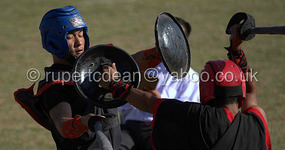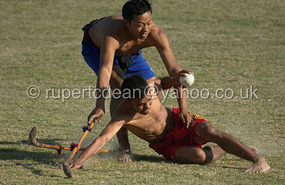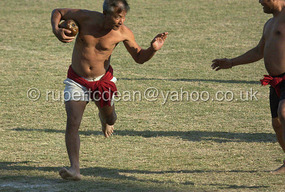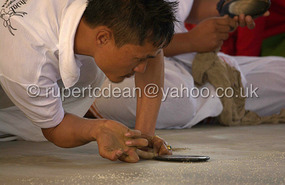Another early morning in Kohima and I had some nice warm sunshine to greet me on the way to the bus station. Amen who looks after the guesthouse in Kohima kindly offered to carry my bag with me to the bus station and watch it whilst I fought for a ticket.
In the end the queues were not the frantic kind that I recalled from the previous year and I was able to get a ticket easily and wait for the bus
. I drew a crowd of interested locals including a few Manipurians whilst we awaited for the bus to arrive and sure enough when it did come it looked no different to those “super-deluxe” buses I had used the previous year. Luckily this one wasn't full. As we were about to depart a frantic German bundled aboard with several bags and introduced himself as Klaus from Berlin. As the bus journey progressed we chatted about travel and India thus helping the journey pass relatively quickly. We crossed into Manipur after a couple of hours and it took some 45 mins to get through the ‘border’ formalities which bizarrely included a stamping of our passports (completely unnecessary) with a Manipurian Stamp and an Ebola test (also unnecessary). Considering the nearest treatment centre for Ebola is 3700 kms away, this procedure seemed a complete waist of time. Anyway the electric thermometer did not work with all 35 people tested in the last two months having exactly the same reading.
I arrived in Manipur on time, despite the efforts of the border formalities
. The Naga Hills were now visible in the distance behind me and Imphal stretched out on a mostly flat plain. Luckily the temperature was a nice mild 26C. The city was reminiscent of so many large Indian cities, crumbling, dirty, dusty, noisy and crowded. The bus dropped me off in the centre by the Maharaja’s old impressive gardens. The Classic Hotel which Nino had recommended was opposite these gardens and next to the hospital. A large window and concrete construction it promised little from the outside, but once inside it was warm, friendly and hospitable. This was actually a little treat for me after many days on the dusty roads of Nagaland. My bronchial cough had returned with savage vengeance and when I spoke with Nino about hotel reservations, this seemed a good idea. Also with the Sangai Festival on, I thought I would be paying over the top for a bed in most of the central locations.
The longer I stayed at the Classic the more I enjoyed it
. It was just like a Western hotel (except the staff were incredibly friendly and the service was of a remarkably high standard), with great beds, good wifi, hot showers, big mattresses and good food. I could not fault it. The Sangai Festival on the other hand was not so well organised and managed. I was unable to find any information in Imphal itself about the program or even where the events were being held. There seemed to be a confusion over what the events were and what time they would start. Certainly the complementary brochure I was given at the Classic answered none of the questions. The website was also unhelpful, but did tantalisingly include a program which seemed to contradict the brochure.
My interest in the Sangai Festival was mostly in the showcase of the region’s indigenous sports. Like the Hornbill Festival in neighbouring Nagaland, the Sangai Festival seems to have confused its original mission statement and now many modern event activities have taken route
. I was told this festival is primarily visited by locals, so much so that the festival’s indigenous activities are relegated to lowly venues and are poorly attended. Music, fashion, food etc now being the major draw cards. For me the interest lay in the indigenous sports such as Kang, the traditional rowing and a little of the Polo. Unfortunately on arrival I was able to ascertain that the scheduling committee had programmed the traditional boat races at the same time as the traditional sports, so that ruled out one of those.
The first morning therefore involved plenty of guesswork and luck. I set off early walking by the canals underneath the lovely trees along the pavements. The local traffic swarmed around me, making crossing the road an adventure sport in itself. The first policeman I asked for directions pointed me in the wrong direction, although I did not know this at the time, and subsequent directions from subsequent officials compounded the problem
. A complete lack of signage did not help. Eventually I managed to find out that I had gone 3 kms past the turning and I had to hop on a communal tuk tuk to return. I managed to arrive at the stadium some 20 mins late. Luckily nothing had started.
I had selected the indigenous sports day as opposed to the traditional boat race. The venue for these events was the Imphal Polo Ground, supposedly the first Polo ground in the world. Manipur claims to have given the world the game of Polo, traditionally played on Manipurian Ponies and Prince Charles is the patron of the Imphal Polo Club. However today the 8th International Polo Tournament was having a rest day and indigenous sports were the prime attraction.
Arriving late I was amazed to find the quite large stadium quite empty. It only ever filled to about 20% capacity during the day. As entrance was free this was more worrying as there appeared to be a warning appetite for these local sports. I was also the only tourist. Very quickly a group of five Manipurians from another town came and sat next to me in the main stand. They were very friendly and only too keen to explain all the rules.
First up the ground was filled with a large number of Martial Arts performers and we enjoyed a long display of Manipur’s martial arts. Children through to women and men performed with swords, machetes and long sticks. They all wore long flowing (almost Middle eastern looking) traditional costumes.
Next up there was Cheibi. This was a sport that may have derived from fencing, but involved a long stick like a baseball bat covered in leather and a small shield. The combatants wore protective head gear and went at each other very aggressively. They fought in an area designated by a large circle with one referee. They were dressed in black and red flowing knee length garments and fought for 3 rounds of 3 minutes. It was all fast and furious. Different points were awarded when a competitor successfully struck different parts of his opponent.
After this two teams of seven players arrived for Mukna Kangjei. This game used about 75% of the Polo pitch. The male players each tied either a red or black piece of material around the naked waists to designate their team. I can only describe this game as a cross between hockey and wrestling with an element of Rollerball thrown in for good measure. This really awoke the crowd who cheered and laughed as the spectacle unfurled in front of us. The hockey sticks appeared marginally longer than those I am familiar with and the ball was also marginally larger.
The aim of the sport was to score goals and this was done when the ball entirely crossed the line. Meanwhile in attempting to facilitate or prevent this, the players literally fight with each other using wrestling techniques such as holding, locking and wrestling either standing or lying on the ground. Mukna is incidentally the Manipurian style of wrestling involving grappling with your opponents team’s identifying waistband and this tactic is also employed here, hence the name Mukna Kangjei.
It was enthralling and entertaining to watch for as the referee launched the game by tossing the white ball in the air, the players just fought and wrestled each other until one or maybe two could break free to carry or hit the ball towards an opponents goal. The game was really a trial of strength which resulted in some epic scraps and clashes on and off the ball. Great fun.
Next up was the one I had been waiting for. A Manipurian version of Rugby, just played with a greased shaved and preserved coconut. Yubi Lakbi is played between two teams of seven to nine players on a small pitch just the width of the Polo ground with only one goal positioned in front of our stand. Sitting on a stool behind the goal was an elder dressed in white robes with an enormous silk white bow on his head. Sort of like an Asian Hilda Ogden, his job was to decorate the goal or try scorer with a giant white shawl.
Each team was again shirtless and differentiated by this material waistband I had seen in the previous sports. They had apparently agreed that one goal would decide the tie. There were two Yubi being (the greased coconut) used and whilst one was in play the other was continually greased on the sidelines.
The game itself appeared to have little or no tactics, just one large pile up after another while players continually stripped the Yubi off each other and wrestled their opponents. As soon as one team got the ball, the opposition immediately defended the goal until it regained position and then the teams’ roles were reversed. All in all this was confusing but interesting. Actually it turned into a rather large stalemate and in end when the whistle went there was a sort of shoot out where the players had to race from one end towards the Yubi, pick it up and run into the goal for the deciding score. A bit of an anti climax and not as exciting as Mukna Kangjei.
After this it was time for the Mukna or Wrestling itself and twenty bouts were staged in front of the stadium. The contestants were dressed as the others with waistbands and shirtless. The wresting area was a small circle in front of the stand and the contestants held onto each other’s waistband whilst trying to feel their opponent out. The object was to manhandle the opponent onto the ground first. Some bouts were quick some were 7 minute trials of brute strength. It certainly absorbed the crowd intently. To me it was not too dissimilar to Sumo wrestling without the requirement of staying in the ring (here, if the wrestlers went outside the circle the bout was halted and then restarted inside the ring). The crowd here was also noisy and keen to witness the bigger men clash.
All in all it was an absorbing an excellent days entertainment and I was quick to thank the men who had sat with me, for their educational explanations. I returned back to the Classic to rest before the next day. Walking into the Classic’s restaurant that evening, I met Klaus who had arrived for a meal and we had a good chat.
The next morning I was up early to book my ticket back to Dimapur on the 30th. Prime Minister Modi was due to visit the Sangai festival on that day so I wanted to get an early bus out to avoid the predicted chaos, Unfortunately the ticket office informed me that there was a general strike that day. Things got worse when I returned to the hotel to find that not only was there a night time curfew planned for the night before, but also the mobiles and internet would probably cease to work. After considering several options, the only solution was to leave Manipur one day early missing two indigenous games and the Polo final on the 29th. This was ever so disappointing as I had planned this trip for months. The only silver lining left was the knowledge that todays and yesterday indigenous games were at least the important ones.
Rather despondently I left to see the Kang tournament that was that day being held at a different venue. I decided against walking and caught a Tuk Tuk. This was a shared tuk tuk and all my fellow passengers united to ensure that this time I found the right place this time. Not that I was looking for what resembled an army based, as that was what I was left standing next too when my fellow passengers told me to alight. I gambled and entered (normally I just would have walked past) and they were right. No signs, posters or indications again. As I walked past the security and army posts it became apparent this was a sporting complex, not unlike a small Olympic village were all sports were located, with stadiums, swimming pools, velodrome and canoeing lake, all in varying states of disrepair. Some buildings reminded me of evacuated Pripyat next to Chernobyl.
Again there was no indication of where the venue was, however I was rescued by a reporter from the Imphal Times and taken to a small building where inside was the Kang. On entering I found a long playing area or court “made with flattened grains” the Journalist said, and at each end seven players from each team all dressed in white flowing robes. The small hall was quiet and the few spectators that turned up seemed transfixed by the action. Unfortunately attendance was not great. A group of 60 school children sat on benches, but most admitted they had no idea what was going on, whereas opposite I sat with the press plus a dozen or so spectators. For what is supposed to be one of the most popular and traditional games in Manipur this was a poor showing. But then publicity and information about the festival are sorely lacking. On closer inspection the game did strike me a similar to lawn bowls (but more complex) and it was obvious that the floor was now marked with cut lines.
As I was talking to the journalist and old man approached and sat next to me. He turned out to be the President of the Kang society in Imphal (or something similar to that effect) and he kindly offered to talk me through the rules. “Its a complicated game,” he started, “if can stay in Imphal for six weeks, i will be able to teach you the basic rules, however to have a complete understanding or even become a master, you will need several years.”
“Its a team game for seven players on each side, he began. “Kang is one of the oldest games in our culture and is named after the disc we use - the Kang. Each team member plays in his turn and there are innings. The Kang itself is the shape of a large drop of water and these days is made from black plastic, but originally was Lac. We understand that originally a seed of a creeper was used. It is between 2.5 and 3.75 cms long in diameter and 0.3 inches thick. The court is 47’ by 20’ and is covered with course flour grains to enable the Kang to glide along when propelled by a player. It is also marked with lines. The players kneel down to propel the Kang by inverting the finger in a type of flicking movement. The Kang is then sent down the court skimming the surface at quite a quick pace. It takes great skill and practice to skim the Kang accurately and correctly.”
The object of the game is to propel the Kang along the court to hit either another Kang or Lamtha Kang or a smaller cube like Chekphei. The Chekphei was aimed at first followed by the Lamtha if this was successful. If the Lamtha was hit twice than a cross court shot was tempted again at the Lamtha. This were how the points appeared to be accumulated and these were displayed on an intricate scoreboard. All in all this was complicated, but absorbing. The old man was right about the nature of the sport and I wondered whether any of the younger Manipurians were interested, as none of the students here were paying any attention. From my point of view, the skills of the players was very evident and it is a very elegant game to watch. I managed nearly three hours but had to leave as I would have missed the chance of seeing the Polo. Each match takes around four hours.
I was so interested in Kang that I think it would be well worth a future trip coming back to explore the country villages of Manipur where it is still played. The old man did offer me a chance of trying the game after the match had finished, but time was against me with my new schedule.
Back at the Polo ground, I arrived to see the last two periods of the second semi final between South Africa and America. I have only seen Polo once when I was young so really had no idea what I was looking at but the large crowd was in boisterous mood and enthralled by the action. There were a good twenty or so foreigners, most if not all involved with the tournament. The game certainly did not disappoint as it went to sudden death before South Africa triumphed. The only thing unusual seemed to be the size of the Manipur ponies who appeared to my untrained eye, tiny.
It was another fine day and the Kang was certainly a highlight together with the Mukna Kangjei (hockey/wrestling) from the previous day. I was still disappointed to leave early but things were beyond my control. That night I talked to the Business Manager of the Classic, Mr Jamkholal Haokip (Jam) who had studied in Cirencester and was an extremely nice man. I had a great Manipurian meal in the restaurant, before an early bed. I will miss both the Manipurian games and this Classic Hotel I mused.
The next morning I was at the bus stop early to get the Winger ( a minibus). This Winger I felt had obviously done this journey more times than I cared to contemplate and was in a bad condition. Uncomfortable with permanently open windows it had a manually controlled fan due to its constant overheating. It did not take long for it to breakdown on the Naga Hills and a six hour journey turned into a ten hour marathon. Wow I was pleased to arrive back at my friend Nungty’s flat in Dimapur, Nagaland.
Sangai Festival - Kang, Hockey/Wrestling, Polo etc
Friday, November 28, 2014
 Imphal, Manipur, India
Imphal, Manipur, India
Other Entries
-
70Incas, Ruins, Trains, Parasites, Veganism
Aug 19101 days prior Cusco, Peruphoto_camera4videocam 0comment 2
Cusco, Peruphoto_camera4videocam 0comment 2 -
71Cloud Forest, Ruins, Birds, Animals, 50th
Aug 2496 days prior Manu National Park, Peruphoto_camera5videocam 0comment 0
Manu National Park, Peruphoto_camera5videocam 0comment 0 -
7250th part 2, Otters, Macaws, Jaguar, Tiramisu
Aug 3090 days prior Puerto Maldonado, Peruphoto_camera6videocam 0comment 0
Puerto Maldonado, Peruphoto_camera6videocam 0comment 0 -
73Finches, Volcanos, Tortoises & Darwin
Sep 0386 days prior Puerto Ayora, Ecuadorphoto_camera7videocam 0comment 0
Puerto Ayora, Ecuadorphoto_camera7videocam 0comment 0 -
74Sharks, Penguins, Sea Lions and Boobys
Sep 1079 days prior Puerto Villamil, Ecuadorphoto_camera6videocam 0comment 0
Puerto Villamil, Ecuadorphoto_camera6videocam 0comment 0 -
75Frigates, Poor Service, Iguanas, Diving Pelicans
Sep 1376 days prior Guayaquil, Ecuadorphoto_camera5videocam 0comment 0
Guayaquil, Ecuadorphoto_camera5videocam 0comment 0 -
76Car Crash, Chachas, Mules and Blood
Sep 1871 days prior Chachapoyas, Peruphoto_camera4videocam 0comment 0
Chachapoyas, Peruphoto_camera4videocam 0comment 0 -
77Kuelap, Mummies, Ruins, Hummingbirds
Sep 2564 days prior Leymebamba, Peruphoto_camera6videocam 0comment 0
Leymebamba, Peruphoto_camera6videocam 0comment 0 -
78Sarcophagi, Fountains of Blood, Horseback
Sep 2861 days prior Cuispes, Peruphoto_camera3videocam 0comment 0
Cuispes, Peruphoto_camera3videocam 0comment 0 -
79Waterfalls, Rain and Loud Peruvian Pop Music
Sep 2960 days prior Pedro Ruiz, Peruphoto_camera4videocam 0comment 0
Pedro Ruiz, Peruphoto_camera4videocam 0comment 0 -
80Hummingbirds, Orchids, Coffee and Stomach Bugs
Oct 0257 days prior Moyobamba, Peruphoto_camera5videocam 0comment 0
Moyobamba, Peruphoto_camera5videocam 0comment 0 -
81Battlefields, Zulus, 1879, Leaving South Africa
Oct 1841 days prior Dundee, South Africaphoto_camera4videocam 0comment 0
Dundee, South Africaphoto_camera4videocam 0comment 0 -
82Mr India, X Factor Naga style, Exotic Food
Nov 0622 days prior Mokokchung, Indiaphoto_camera5videocam 0comment 0
Mokokchung, Indiaphoto_camera5videocam 0comment 0 -
83Burma, Headhunters, Opium & Dust
Nov 0919 days prior Launghe, Myanmarphoto_camera4videocam 0comment 0
Launghe, Myanmarphoto_camera4videocam 0comment 0 -
84History, bad guesthouses, hills, Wakching
Nov 1414 days prior Mon, Indiaphoto_camera4videocam 0comment 0
Mon, Indiaphoto_camera4videocam 0comment 0 -
85Skulls, Fertility, Opium, Anghs, Warriors
Nov 1711 days prior Shengnya, Indiaphoto_camera5videocam 0comment 0
Shengnya, Indiaphoto_camera5videocam 0comment 0 -
86Elders, Changs, Culture, Families and Skulls
Nov 226 days prior Tuensang, Indiaphoto_camera5videocam 0comment 0
Tuensang, Indiaphoto_camera5videocam 0comment 0 -
87Sangai Festival - Kang, Hockey/Wrestling, Polo etc
Nov 28 Imphal, Indiaphoto_camera5videocam 0comment 0
Imphal, Indiaphoto_camera5videocam 0comment 0 -
88Hornbill Festival, Loin Looms & Naga Culture
Dec 1012 days later Kohima, Indiaphoto_camera10videocam 0comment 0
Kohima, Indiaphoto_camera10videocam 0comment 0 -
89Birds, Rubbish, Grasslands, Rubble, Tribes etc
Dec 1416 days later Nakhatrana , Indiaphoto_camera5videocam 0comment 0
Nakhatrana , Indiaphoto_camera5videocam 0comment 0 -
90Embroidery, Rogan, Block Printing, Tribes
Dec 1719 days later Bhuj, Indiaphoto_camera5videocam 0comment 0
Bhuj, Indiaphoto_camera5videocam 0comment 0 -
91Lions, Nitin, Bird Spotting, Sleeper Bus Part 1
Dec 2123 days later Gir, Indiaphoto_camera6videocam 0comment 0
Gir, Indiaphoto_camera6videocam 0comment 0 -
92Island Life, Portuguese Colony, Christmas
Dec 2527 days later Diu, Indiaphoto_camera4videocam 0comment 0
Diu, Indiaphoto_camera4videocam 0comment 0 -
93Restaurant Tombs, Mosques, Markets
Dec 2830 days later Ahmedabad, Indiaphoto_camera5videocam 0comment 0
Ahmedabad, Indiaphoto_camera5videocam 0comment 0 -
94Birds, NYE, Dhows, Feral Dogs, Shaves
Dec 3133 days later Mandvi, Indiaphoto_camera6videocam 0comment 0
Mandvi, Indiaphoto_camera6videocam 0comment 0 -
95Blue Moon, Salt Flats, Crafts
Jan 0235 days later Bhujodi, Indiaphoto_camera5videocam 0comment 0
Bhujodi, Indiaphoto_camera5videocam 0comment 0 -
96Calico Musuem, Festival Prep, Street Life
Jan 0639 days later Ahmedabad, Indiaphoto_camera5videocam 0comment 0
Ahmedabad, Indiaphoto_camera5videocam 0comment 0 -
97Leopards, Shepherds, Turbans and Aristocrats
Jan 1144 days later Bhenswara, Indiaphoto_camera5videocam 0comment 0
Bhenswara, Indiaphoto_camera5videocam 0comment 0 -
98Birds, Fog, Bad Internet, Old Friends
Jan 1447 days later Jodhpur, Indiaphoto_camera7videocam 0comment 0
Jodhpur, Indiaphoto_camera7videocam 0comment 0 -
99Tigers Tigers Tigers Tigers and oh Tigers
Jan 1750 days later Sawai Madhopur, Indiaphoto_camera6videocam 0comment 0
Sawai Madhopur, Indiaphoto_camera6videocam 0comment 0 -
100Trains, Rodents, Rip offs, Delhi and Gentle
Jan 2558 days later Delhi, Indiaphoto_camera3videocam 0comment 0
Delhi, Indiaphoto_camera3videocam 0comment 0 -
101Sand, Masks, Forest Man, Monks & Bamboo
Feb 0266 days later Majuli, Indiaphoto_camera8videocam 0comment 0
Majuli, Indiaphoto_camera8videocam 0comment 0 -
102Julius, Gibbons, Park Fees, Tea & Gymkhana
Feb 0569 days later Jorhat, Indiaphoto_camera5videocam 0comment 0
Jorhat, Indiaphoto_camera5videocam 0comment 0 -
103Houseboats, Dolphins, Rain and Animal Planet
Feb 1074 days later Tinsukia, Indiaphoto_camera5videocam 0comment 0
Tinsukia, Indiaphoto_camera5videocam 0comment 0 -
104Tezu family home, TV Mike, Huts, Cows, River Wash
Feb 1478 days later Tezu, Indiaphoto_camera5videocam 0comment 0
Tezu, Indiaphoto_camera5videocam 0comment 0 -
105Sumos, Boulders, Oranges, Idu Mishmi
Feb 1781 days later Roing, Indiaphoto_camera5videocam 0comment 0
Roing, Indiaphoto_camera5videocam 0comment 0

 Imphal, Manipur, India
Imphal, Manipur, India









2025-05-22